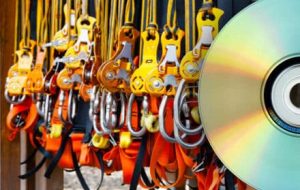Subpart D – Walking-working Surfaces
Home More Training Resources OSHA General Industry Training Requirements Subpart D – Walking-working Surfaces
OSHA Training Requirements - Subpart D - Walking-working Surfaces
This website is not the official or final authority to determine OSHA compliance responsibilities, which are set forth in OSHA standards themselves, and the Occupational Safety and Health Act of 1970. Because OSHA regulations are constantly being added, deleted, and/or revised, you must not rely on this website as the official or final authority of OSHA training requirements; refer to the official OSHA regulations available on OSHA’s website (osha.gov). – See disclaimers.
Subpart D – Walking-Working Surfaces
1910.21(b) – Definitions. The following definitions apply in this subpart:
Qualified describes a person who, by possession of a recognized degree, certificate, or professional standing, or who by extensive knowledge, training, and experience has successfully demonstrated the ability to solve or resolve problems relating to the subject matter, the work, or the project.
1910.22 – General Requirements
(d)(3) – When any correction or repair involves the structural integrity of the walking-working surface, a qualified person performs or supervises the correction or repair.
1910.27 – Scaffolds and rope descent systems
(a) – Scaffolds. Scaffolds used in general industry must meet the requirements in 29 CFR part 1926, subpart L (Scaffolds).
(b) – Rope descent systems
(i) – Before any rope descent system is used, the building owner must inform the employer, in writing that the building owner has identified, tested, certified, and maintained each anchorage so it is capable of supporting at least 5,000 pounds (268 kg), in any direction, for each employee attached. The information must be based on an annual inspection by a qualified person and certification of each anchorage by a qualified person, as necessary, and at least every 10 years.
(2) – Use of rope descent systems. The employer must ensure:
(iii) Each employee who uses the rope descent system is trained in accordance with § 1910.30;
1910.28(b) – Protection from fall hazards
(1) – Unprotected sides and edges
(iii) – When the employer can demonstrate that the use of fall protection systems is not feasible on the working side of a platform used at a loading rack, loading dock, or teeming platform, the work may be done without a fall protection system, provided:
(A) – The work operation for which fall protection is infeasible is in process;
(B) – Access to the platform is limited to authorized employees; and,
(C) – The authorized employees are trained in accordance with § 1910.30.
(4) – Dockboards.
(i) – The employer must ensure that each employee on a dockboard is protected from falling 4 feet (1.2 m) or more to a lower level by a guardrail system or handrails.
(ii) – A guardrail system or handrails are not required when:
(A) – Dockboards are being used solely for materials-handling operations using motorized equipment;
(B) – Employees engaged in these operations are not exposed to fall hazards greater than 10 feet (3 m); and
(C) – Those employees have been trained in accordance with § 1910.30.
(8) – Repair pits, service pits, and assembly pits less than 10 feet in depth. The use of a fall protection system is not required for a repair pit, service pit, or assembly pit that is less than 10 feet (3 m) deep, provided the employer:
(i) – Limits access within 6 feet (1.8 m) of the edge of the pit to authorized employees trained in accordance with § 1910.30;
(ii) – Applies floor markings at least 6 feet (1.8 m) from the edge of the pit in colors that contrast with the surrounding area; or places a warning line at least 6 feet (1.8 m) from the edge of the pit as well as stanchions that are capable of resisting, without tipping over, a force of at least 16 pounds (71 N) applied horizontally against the stanchion at a height of 30 inches (76 cm); or places a combination of floor markings and warning lines at least 6 feet (1.8 m) from the edge of the pit. When two or more pits in a common area are not more than 15 feet (4.5m) apart, the employer may comply by placing contrasting floor markings at least 6 feet (1.8 m) from the pit edge around the entire area of the pits; and
(iii) – Posts readily visible caution signs that meet the requirements of § 1910.145 and state “Caution-Open Pit.”
(10) – Outdoor advertising (billboards).
(ii) – When an employee engaged in outdoor advertising climbs a fixed ladder before November 19, 2018 that is not equipped with a cage, well, personal fall arrest system, or a ladder safety system the employer must ensure the employee:
(A) – Receives training and demonstrates the physical capability to perform the necessary climbs in accordance with § 1910.29(h);
(14) – Slaughtering facility platforms.
(ii) – When the employer can demonstrate the use of a guardrail or travel restraint system is not feasible, the work may be done without those systems provided:
(A) – The work operation for which fall protection is infeasible is in process;
(B) – Access to the platform is limited to authorized employees; and
(C) – The authorized employees are trained in accordance with § 1910.30.
1910.30 – Training Requirements
(a) – Fall hazards
(1) – Before any employee is exposed to a fall hazard, the employer must provide training for each employee who uses personal fall protection systems or who is required to be trained as specified elsewhere in this subpart. Employers must ensure employees are trained in the requirements of this paragraph on or before May 17, 2017.
(2) – The employer must ensure that each employee is trained by a qualified person.
(3) – The employer must train each employee in at least the following topics:
(i) – The nature of the fall hazards in the work area and how to recognize them;
(ii) – The procedures to be followed to minimize those hazards;
(iii) – The correct procedures for installing, inspecting, operating, maintaining, and disassembling the personal fall protection systems that the employee uses; and
(iv) – The correct use of personal fall protection systems and equipment specified in paragraph (a)(1) of this section, including, but not limited to, proper hook-up, anchoring, and tie-off techniques, and methods of equipment inspection and storage, as specified by the manufacturer.
(b) – Equipment hazards.
(1) – The employer must train each employee on or before May 17, 2017 in the proper care, inspection, storage, and use of equipment covered by this subpart before an employee uses the equipment.
(2) – The employer must train each employee who uses a dockboard to properly place and secure it to prevent unintentional movement.
(3) – The employer must train each employee who uses a rope descent system in proper rigging and use of the equipment in accordance with § 1910.27.
(4) – The employer must train each employee who uses a designated area in the proper set-up and use of the area.
(c) – Retraining. The employer must retrain an employee when the employer has reason to believe the employee does not have the understanding and skill required by paragraphs (a) and (b) of this section. Situations requiring retraining include, but are not limited to, the following:
(1) – When changes in the workplace render previous training obsolete or inadequate;
(2) – When changes in the types of fall protection systems or equipment to be used render previous training obsolete or inadequate; or
(3) – When inadequacies in an affected employee’s knowledge or use of fall protection systems or equipment indicate that the employee no longer has the requisite understanding or skill necessary to use equipment or perform the job safely.
(d) – Training must be understandable. The employer must provide information and training to each employee in a manner that the employee understands.

On Site OSHA Training Classes

Online OSHA Training Courses

